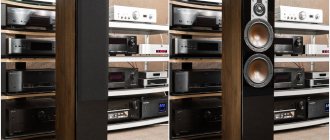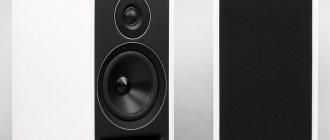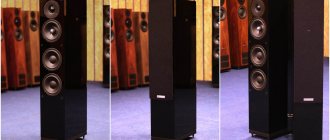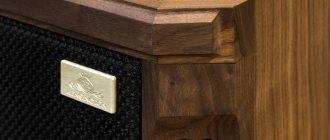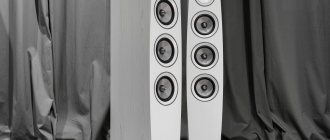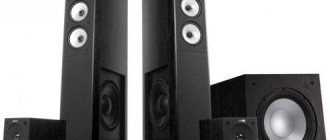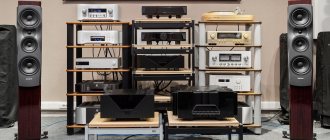The Danish company DALI has a very wide range of acoustics, which is also regularly updated. At the same time, developers and marketers year after year cope with a very difficult task: maintaining a single sound signature and an equally interesting price/quality ratio in each price group. All this allows brand lovers to easily upgrade, moving up the model range. Only one question remains: which series can you stop at in search of perfection? There is an opinion that Rubicon is exactly that level.
Tradition and technology
The way DALI engineers achieve a consistent sound character is no big secret - the same materials and technologies are used in all models. The difference in sound quality from series to series is determined only by the quantity and novelty of the technological solutions used. And Rubicon is no exception in this regard.
The appearance of the DALI Rubicon is quite recognizable
The midrange/bass driver has a well-recognized dark red paper diffuser. In its composition, ordinary cellulose pulp is reinforced with coarser and stiffer wood fibers, which makes it possible to achieve higher diffuser strength for efficient operation in piston mode. In addition, a mixture of fibers of different densities makes the internal structure of the diffuser non-uniform, thereby minimizing internal resonances.
The speaker design uses a ring ferrite magnet, and for better distribution of the magnetic field in the core of the magnetic system, a soft magnetic SMC compound and a perforated copper cap are used. This approach minimizes distortion and makes the sound extremely clear at all volume levels.
Branded emitters with diffusers made of cellulose reinforced with wood fibers are found in different DALI models
High frequencies are reproduced by a soft dome tweeter. Its larger 29mm size provides more convincing low-treble reproduction and, as a result, better matching with the larger 165mm mid/bass driver.
Rubicon 8 Customization Features
When we ordered the Rubicon passive speakers, we couldn't find a subwoofer from DALI that was powerful enough to fill a spacious studio with distinctive bass. Therefore, we decided to order the system without a subwoofer. We listened to a ton of music in a variety of formats using just a pair of Rubicon 8 speakers, and as you'll see below, even in our large room, they sounded excellent from a low 38Hz all the way up to 34 kilohertz.
Next we will discuss one of the most important issues related to this audio system. Namely: how the Rubicon 8 acoustic pair copes with the role of a home theater. In short, they can easily cope without a subwoofer if the size of your room can be called “modest”. Also, Rubicon floorstanding speakers are suitable for those listeners who are used to listening to music at reasonable volume levels, as well as fans of films that do not require much emphasis on the extreme part of the bass.
While watching, we set the volume levels higher than for music. Of course, for movies like X-Men or Mission: Impossible, you'll likely need to amplify this speaker pair with a subwoofer. And other than balancing the center channel's low frequencies using a processor-amplifier, the review did not use any other technique to equalize the sound of the Rubicon floorstanding speakers.
Note: After we received a pair of Rubicon 8 passive floorstanding towers, DALI consultants came to us with a recommendation for a proprietary subwoofer with a 14-inch speaker and a 500-watt amplifier - SUB-K-14F . Obviously, this advice is no longer relevant for us, but you can take a closer look at this component if you need a DALI subwoofer for your home audio system.
The left and right speakers of the Rubicon 8 were installed about 2.5 meters apart, while the distance from the back of the speakers to the wall was 1.2 meters.
DALI recommends that users place their speakers not too close to a wall and face them straight into the room so that the left and right channels are not facing each other. This is the only way the sound waves will not be layered, which means we will get a clear overall sound signature of the system.
We listened to the manufacturer's advice and placed the speakers in one line, parallel to the wall. It is worth noting that for many listeners this can be quite problematic, since their sofa/chair is not located opposite the speaker system, but somewhere to the side. Moreover, we are sure that there will be users who prefer to watch movies on the big screen from a certain angle.
Let's say up front that it will be quite difficult to find a suitable position in which the eights will get the space they need (and the sound will not be shifted from the conditional “center” to the array of speakers that is closer to you). Note that due to the foresight of DALI speakers, the muting of one of the channels will not be a noticeable problem for you.
Out of time
When it comes to design, the DALI Rubicon 2 has a timeless quality. The placement of the drivers and the general appearance of the facade are reminiscent of several series released in recent years, including the flagship Epicon 2. The shape of the cabinet with curved front and rear panels is somewhat similar to the shape of the Mentor series speakers. It would seem that there are no new components, but it looks quite fresh and modern. There is no outright luxury and pathos of Epicon, but it looks expensive and solid.
The version we tested came in walnut veneer, and there are four options in total. Another veneer color is mahogany, black or white varnish. Depending on the interior, different options will look more advantageous. The walnut version fit perfectly into the interior of the AV Comfort cabin, where testing took place, and it would be difficult for me to imagine another in its place.
With or without grill, the shining DALI logo will always be visible
Classic grille fastenings with pins are cleverly combined with the mounting points for the speakers - as a result, there is one “extra” hole on the facade in the upper part of the decorative tweeter overlay, and it does not spoil the appearance at all, but rather adds intrigue. Another accent: the polished logo, which is present both on the grill and on the speaker body.
Active wireless speakers DALI Rubicon 2 C
There is every reason to consider these small active monitors to be the most advanced wireless systems in a compact format. Their class will surely satisfy the most demanding music lovers. And the price, judging by sober calculation and not emotionality, is not at all prohibitive.
Typically, all electronic innovations designed to provide new user conveniences begin their journey from the bottom - with inexpensive mass-produced equipment. The same Bluetooth “entered” audio in exactly this way: first, wireless telephone headsets appeared, then Bluetooth speakers and BT soundbars entered the arena... Only after that did Hi-Fi manufacturers begin to introduce the technology into receivers, advanced headphones and acoustics. Many companies that produce audiophile-level equipment today try to stay away from those technologies that do not inspire confidence among the conservative part of audiophiles. Convenience is, of course, good, but your reputation is more expensive.
In fact, we have before us slightly modified Rubicon 2 two-way speakers with their advanced drivers: a 16.5-cm woofer and a 29-mm textile tweeter.
However, DALI decided to take a risk and two years ago they produced wireless acoustics Callisto, which, out of caution, was separated from the main range. Its beauty was that the signal from the sources was first transmitted to a special hub (in any form - digital or analog), and the “distribution” directly to the speakers was carried out using a special digital protocol with a quality of 24 bit/96 kHz without psychoacoustic compression and other channel losses. And we have already appreciated Callisto’s advanced radio interface: the systems received the “Expert’s Choice” award.
We now see the same technology in higher-level systems - in Rubicons. The high class of this series is beyond doubt. It features a rich finish (available in three versions: natural walnut, black or white lacquer), carries a range of signature know-how and is made with impeccable attention to every detail.
The only question that remains open is the price. Not everyone is mentally prepared to shell out several hundred thousand rubles for a couple of small speakers. Well, let's start with the most banal thing - with calculation.
The heads in the active version are connected directly to the terminals, that is, band division, phase matching and level equalization are carried out in the audio processor.
In fact, we have before us slightly modified Rubicon 2 two-way speakers with their advanced drivers: a 16.5-cm woofer and a 29-mm textile tweeter. The first, we recall, is notable for its diffuser made of impregnated cellulose with the addition of wooden fibers and, most importantly, a magnetic system made of SMC compound and complemented by a copper magnetic cap (both solutions allowed DALI engineers to significantly reduce the negative impact of eddy currents in the driver and those introduced into the sound distortion). The second head has an ultra-light dome, which is loaded onto a compact return chamber, and the “engine” is a lightweight copper-plated aluminum coil placed in a field of ferrite that is quite impressive in size.
So, the passive version of Rubicon 2 is offered for 143 thousand rubles. And a pair with an active “surcharge” already costs 276, and it is 86 thousand more expensive than the active analogues of Callisto 2. If you order Rubicon 2 C complete with a hub and a BluOS module (more on that later), then the finished setup will cost three hundred, and thus the difference with the passive version will already be 157 thousand. Expensive? Let's calculate how much a ready-made system with comparable functionality based on conventional components with “Rubicon-twos” will cost. We will need an integrated circuit, and this is immediately plus at least a hundred, if you select an amplifier adequate in class, speaker cables (another plus 15 - 20 thousand) and a streamer / DAC with BluOS (which, consider, is not present - so far only the NAD C658 has the necessary functionality for 140 thousand). Total: under 400 thousand. There is a difference?
There is another system option: paired with regular Rubicon 2, some kind of network amplifier or receiver with BluOS is installed. But here we limit ourselves even more severely in the choice (today only NAD produces such components) and... again we either save nothing or lose a little in class. Whatever one may say, the configuration based on Rubicon 2 C is still more profitable, if only because it simply includes everything. It does not need to be supplemented with expensive components and accessories.
What is an active “surcharge”? This is indicated by an LED volume indicator strip in each speaker. In place of the usual terminal panel there is a “Link&Connect” connection button via the radio interface, an indicator for selecting the speaker position (you can “connect” not one stereo pair to the hub, but two in parallel), a USB service socket and an analog RCA input, allowing you to use speakers if necessary and in a wired version. Inside each speaker, the path begins with a digital receiver and ADC, passes through a high-performance DSP, is converted to analog by Burr-Brown PCM1796 chips, and from there the signal in differential form is sent to class D amplifiers, made using the most modern circuitry - with modulation error correction. I would like to draw your attention to the fact that the heads in the active version are connected directly to the terminals, that is, band division, phase matching and level equalization are carried out in the audio processor. And volume control, on the contrary, is not performed at the beginning of the path, but after all the transformations, and this means that the actual signal resolution never drops below 24 bits. As you can see, everything is very competent.
Standard quality files from an external drive or server sound a little better than from any digital input, and are so musical that it’s even unusual.
The Sound HUB also deserves special mention, because it gives our active speakers the functionality of a complete system. It is powered by an external adapter and is complemented by a remote control. This box looks like a stylish pre with a volume control and a simple push-button selector, but its function is not so much “regulatory” as “distributive” - it prepares any signal received on it for wireless output, and at the same time synchronizes all system controls. The device has two line inputs (RCA and a thin jack) and three digital inputs - coaxial and two optical. It is possible to route the signal to a subwoofer or external amplifier.
The connection capabilities are complemented by a built-in Bluetooth module with aptX HD, a USB Type-A socket (you can connect Chromecast to it) and two expansion slots, one of which already has an NPM-1 BluOS unit installed in our system. It turns the hub into a powerful network device on the Bluesound streaming platform. This means that you will have access to not two or three popular streaming services like Tidal or Deezer, but 20. The system will be able to be controlled in multi-zone mode and play almost all files in Hi-Res and MQA Studio Master Quality over a home network. And it can index up to 250,000 such compositions stored in your local digital collection.
That's why in this review we physically cannot describe the sound quality for all use cases and from all sources - there are too many of them. Let's leave this for the future, when we get acquainted with the floor-standing Rubicon 6 C, and today we will focus on the basis: on the BluOS platform, on the quality of its implementation in wireless speakers and on the audiophile abilities of the monitors themselves.
The system does not require advanced settings and, in general, does not need them - in the BluOS application, only the volume normalization setting can affect the sound quality (all other Setup items are purely service). This alone creates the right aura of non-interference in the original sound.
If some traditional system with a separate amplifier and ordinary acoustics immediately sounded like this, we would be happy.
The wireless protocol, no matter how much we listened closely to the most memorized tracks, trying to catch at least some inaccuracies in their presentation, passes through purely. There is no jittery “causticity” or defocusing of apparent images, nor the “toasted” tones characteristic of PCM or digital granulation in the sound. On the contrary, the music is played softly, with tact, with excellent balance, without any annoying tones or lost timbres.
It's cool that at any volume setting the scene is demonstrably three-dimensional. Standard quality files from an external drive or server sound a little better than from any digital input, and are so musical that it’s even unusual. MQA content surprises with its spatial accuracy rather than its euphony. Other content in high-res is reproduced differently - some of the tracks are captivating with excellent stage visualization and lively tones, while some benefit only in information content (it seems that the system has such a high resolution that it allows you to distinguish not only remasters from the originals, but also files that have been converted from other Hi-Res formats). But in any case, already at a comfortable volume level you get a rich microdynamic background, and at a higher volume you get adequate full-bodied dynamics. It is only slightly formalized (the contrasts are clear, but the subtle articulation of the performer is still a little squeezed), but even at the most powerful levels the sound does not become primitive, bright or “bald” - power, tonal saturation, and strong details are preserved.
If some traditional system with a separate amplifier and ordinary acoustics immediately sounded like this, we would be happy - there is no need to select cables, solve the eternal dilemma of compatibility of the terminal and the load, or look for compromises between three-dimensionality and musical balance. This is the case when the equipment just needs to be installed correctly and turned on - it will give out what you need.
But the most surprising thing is that there is nothing in the sound of the active versions that could be attributed to pulse amplification, which is unloved by many audiophiles. No harshness at the top, no excessive static at the bottom, no chill in the middle. Of course, this is not the sound that is similar to “temperate tube”, but you cannot deny its openness, integrity and plasticity. And it certainly has what the Rubicons are valued for.
We didn't have a chance to directly compare the Rubicon 2 C to their passive counterparts. But if such a duel had taken place, then the active models would certainly have won in at least three aspects: in the accuracy of the interpretation of low frequencies, in the texture and damping of the midbass, in the accuracy and “materialization” of the rendered images.
By the way, the active version is great for installation close to walls - even in an unfavorable area, we did not notice any humming sounds, lagging bass or loss of depth in the scene. For audiophiles living in not very large apartments, this may be the most valuable advantage of the new acoustics.
SYSTEM
Sources
- smartphone OPPO Reno, Apple iPhone 8
- laptop Apple MacBook Air A1465
- network receiver Naim Uniti Nova
- Naim Uniti Star music server
Cables
- digital 75 Ohm Audioquest VDM-3
- interconnect Atlas Mavros Ultra RCA
DALI Rubicon 2 C
Manufacturer: DALI A/S (Denmark)
www.dali-speakers.com/ru/
Configuration: 2 emitters, 2 bands || Acoustic design: bass reflex || Input: RCA || Input Sensitivity: 1.4 V (5K Ohm Resistance) || Wireless Protocol: 2.4/5.8 GHz (24 bit/96 kHz) || Frequency range: 46 - 26000 Hz (+/-3 dB) || Active crossover frequency: 2600 Hz || Power of built-in amplifiers: 250 W || Maximum sound pressure level: 108 dB || Standby/Max Power Consumption: 1.2/325W || Finish: Walnut veneer, white or black || Dimensions (WxHxD): 195 x 353 x 335 mm || Weight 1 piece: 8.4 kg || Price per pair: 275,990 .
DALI Sound HUB
Inputs: stereo pair RCA, 3.5 mm jack, 2 TOSLink, Coax, two compartments for plug-in modules || Input sensitivity RCA/jack: 2.3/1.2 V (resistance 10 kOhm) || Outputs: stereo pair RCA, SUB, USB Type A || Output voltage RCA/SUB: 1.9/0.9 V (resistance 10 kΩ) || Wireless protocols: Bluetooth 4.2 AAC/aptX/aptX HD, 2.4/5.8 GHz (24 bit/96 kHz) || Standby/Max Power Consumption: 2.5/4.5 W || Finish: Black || Dimensions: 300 x 76 x 213 mm || Weight 1 piece: 1.6 kg || Price (with BluOS module): 76,490 .
share
Tags: DALIDALI Rubicon 2 C Good buy
On the verge of perfection
I chose Quad Artera Solus as a source and amplifier - a device that is not only familiar, but also well proven. High resolution, neutral tonal balance and a powerful, energetic amplifier are exactly what our test subjects should like.
The first feeling that arose when listening to Rubicon 2 was the absence of any audible coloration and distortion introduced by the acoustics. The hackneyed phrases that “the speakers seemed to disappear into the room, leaving us alone with the music” are fully and quite literally applicable to this situation. With a classic arrangement with the direction of the radiation axis towards the listener, you can get a three-dimensional and realistic sound picture that is not tied to acoustics in terms of localization. The only thing that allows us to understand that we are not looking at spherical rainbow supermonitors filled with magic, but quite real home bookshelf speakers, is the nature of the sound of low frequencies.
The curved façade of the building is not only beautiful, but also effective in terms of dispersing reflected sound waves
The bookshelf speakers are capable of reproducing fairly deep bass notes, but the moment when the bass reflex comes into play is easy to hear. On “In Your Wild Garden” by Josefine Cronholm, the double bass sounded like a roller coaster ride. The main melody sounded extremely clear, but it was mainly the upper bass, which gave the impression that the acoustics were playing frankly in a shelf-like manner, without attempting to reproduce the lower notes. And suddenly the bass reflex comes into play, producing, instead of the expected failure, a completely weighty and comprehensive bass that surrounds the listening position from all sides. It is clear that, unlike the focused notes of the upper bass, the lower notes are less focused and precise, but in most musical genres this presentation did not create serious problems.
The flanges of both speakers have a soft rubberized surface
Classical music, jazz, blues and rock sounded full, without causing any desire to interfere with the system configuration. On metal and heavy alternative music, I lacked density and richness in the sound of the mid-bass, but at the same time I was pleased with the intelligible sound of the guitars, the ability of the acoustics to clearly handle high-speed moments and convey the energy of the performance as a whole. To finally make Rubicon 2 more comfortable with these genres, I would use bass reflex plugs and a powerful subwoofer with a closed cabinet. By the way, for electronic dance music I recommend the same recipe.
Powerful terminals and a bass reflex on screws - everything is very serious!
With the exception of this point, the general description of the sound nature of the acoustics can be considered complete, because there are absolutely no complaints about the reproduction of the rest of the frequency range. The acoustics are perfectly tonally balanced and reproduce music reliably.
Subtle Essences
While listening to David Bowie's "Blackstar," I noticed how deeply and accurately the Rubicon 2 handled the subtle nuances of vocals. A tense, slightly trembling voice added depth and completeness to the overall picture. High detail was also evident on the song “Muddy Waters” LP - every voice in the choir, every bell-noisemaker in the percussion part could be decomposed into individual sounds. But by giving this opportunity, DALI Rubicon 2 in no way calls for this; rather, on the contrary, they strive to present the music as a whole, as a single canvas. There is more emotion and energy in the presentation than analytics and attention to individual components.
Polished natural veneer looks great
I really liked how clearly and beautifully the acoustics handle dynamic bursts and suddenly hanging silence in the air. This was perfectly felt on “Hedonism” by Skunk Anansie and on “Fever” performed by Elvis. The half-timers cope with everything that concerns dynamics, including practicing fast moments and sharp transitions from piano to forte - this was clearly demonstrated by symphonic classics. It is important to note that the acoustics sound equally interesting at different volume levels. It doesn’t hide nuances when it sounds quiet, and doesn’t go into overload when the volume knob is cranked up to the max.
Movie time with Rubicon 8
As impressed as we were by the pair of Rubicon 8s in music, they caught our attention even more when watching movies. Let us immediately draw your attention to the fact that for films we have added a subwoofer to the Rubicon passive systems. As we said earlier, for these purposes you can consider an active subwoofer made by DALI for better integration into the audio system.
Now about the sound. The opening music in the film “Jack Reacher” with Tom Cruise instantly immerses you in the atmosphere of the film: heavy and dynamic action, intense passions, balance between life and death. With its combination of great music and sudden gunshots that seem to pierce the air, this film has never sounded better than on Rubicon Towers.
But this is just the beginning. In the opening scenes of Ridley Scott's horror film Prometheus, we were mesmerized by the sight of a spaceship approaching. From there to the “transformation” scene, incredibly fragile details like the crunch of a DNA molecule breaking, the sound of liquid flowing, and more, the Rubicon 8 nailed it all.
Bottom line: If you can provide enough free space for listening/viewing with Rubicon speakers, they will give you the vibrant and majestic sound of your favorite movies and music. To create a more focused and spacious soundstage, follow the manufacturer's advice regarding audio placement.
Our review of the DALI Rubicon 8
There is a lot of competition in the price category of “premium” acoustics, in which, in addition to DALI Rubicon devices, there are many other worthy models. We would never recommend that anyone choose or compare audio packages based on a single review, as even the most detailed review cannot provide all the information needed.
And if you have the opportunity to listen to the speakers before purchasing, be sure to do so. Again, as is the case with other premium models, Rubicon is distinguished by high build quality, balanced frequency response and technological components. But let’s not forget that when choosing a home audio system, you need to focus on your sound preferences and the space features of the room in which you want to place the speakers.
You can buy passive acoustics DALI Rubicon 8 HERE
Author of the publication
offline 2 hours

